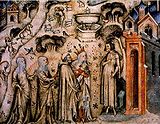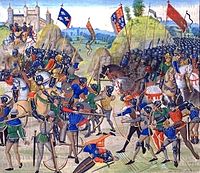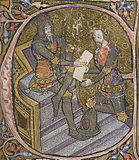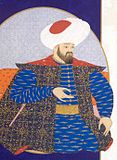Background to the schools Wikipedia
SOS believes education gives a better chance in life to children in the developing world too. SOS Children has looked after children in Africa for forty years. Can you help their work in Africa?
| Millennium: |
2nd millennium |
| Centuries: |
|
| Decades: |
1300s 1310s 1320s 1330s 1340s
1350s 1360s 1370s 1380s 1390s |
| Categories: |
Births – Deaths
Establishments – Disestablishments |
As a means of recording the passage of time, the 14th century was the century which lasted from January 1, 1301, to December 31, 1400.
Events

This 14th-century statue from south
India depicts the gods
Shiva (on the left) and Uma (on the right). It is housed in the Smithsonian Institution in
Washington, D.C..
- The transition from the Medieval Warm Period to the Little Ice Age.
- Beginning of the Ottoman Empire, early expansion into the Balkans.
- Early 14th century - Attributed to Kao Ninga Monk Sewing is made. Kamakura period. It is now kept at The Cleveland Museum of Art.
- The Avignon papacy transfers the seat of the Popes from Italy to France
- The Great Famine of 1315-1317 kills millions of people in Europe.
- Forced out of previous locations, the Mexica found the city of Tenochtitlan in 1325
- The death of the Ilkhan Abu Said in 1335, causing the disintegration of the Mongol rule in Persia.
- Battle of Kosovo in 1389 between Serbs and Ottoman Turks, Prince Lazar, sultan Murat I and Miloš Obilić were killed
- The Vijayanagara Empire is founded in South India by Harihara in 1336
- The Hundred Years' War begins when Edward III of England lays claim to the French throne. ( 1337) The French recruit troops and ships in Genoa, Monaco and Nice. ( 1345– 1346)
- Black Death kills around a third of the population of Europe. ( 1347– 1351).
- The Battle of Lake Poyang, a naval conflict between Chinese rebel groups led by Chen Youliang and Zhu Yuanzhang, took place in August to October of 1363, and was one of the largest naval battles in history.
- The end of Mongol Yuan Dynasty in China and the beginning of the Ming Dynasty ( 1368)
- The Lollardy movement rises in England
- The Great Schism of the West begins in 1378, eventually leading to 3 simultaneous popes.
- An account of Buddha's life, translated earlier into Greek by St John of Damascus and widely circulated to Christians as the story of Barlaam and Josaphat, became so popular Buddha (under the name Josaphat) was made a Catholic saint.
- Singapore emerges for the first time as a fortified city and trading centre of some importance.
- Reunification of Poland under Ladislaus I of Poland
- Ciompi Revolt in Florence
- Peasants' Revolt in England
- Islam reaches Terengganu, on the Malay Peninsula.
- The Hausa found several city-states in the south of modern Niger.
- The Mali Empire expands westward and conquers Tekrur.
- The poet Petrarch coins the term Dark Ages to describe the preceding 900 years in Europe, beginning with the fall of the Western Roman Empire in 476 through to the renewal embodied in the Renaissance.
- The Scots win the Scottish Wars of Independence.
- Union of Krewo between Poland and Lithuania.(1385)
- Work begins on the Great Enclosure at Great Zimbabwe, built of un-cemented, dressed stone. The city's population is now between 10,000 and 40,000.
- Beginning of the Renaissance in Italy
- The Kalmar Union is established in 1397, uniting Norway, Sweden and Denmark into one kingdom.
- Iwan vault, Jamé Mosque of Isfahan, Isfahan, Persia (Iran), is built.
Significant people

Guillaume de Machaut (at right) receiving Nature and three of her children, from an illuminated Parisian manuscript of the 1350s
- Ibn Battuta, Berber Muslim traveler ( 1304– 1368/ 1377)
- Chen Youliang, Chinese rebel leader and arch nemesis to Zhu Yuanzhang (aka Emperor Hongwu)
- Jiao Yu, Chinese general and author of the Huolongjing military treatise
- Liu Ji, a Chinese general, court advisor, philosopher, and co-editor of the Huolongjing
- William of Ockham, English Franciscan friar and philosopher (c. 1285– 1347)
- Alauddin Khilji, an Afghanized Turk ruler, strongest emperor of his age, ruling from Delhi over South Asia, crushing Mongol invasions and Rajput rebellions.
Artists
- Giotto di Bondone, Italian painter (c. 1267– 1337)
- Simone Martini, Italian painter ( 1284 – c. 1344)
- Stephen of Perm, Russian icon painter ( 1340– 1396)
Literary figures
- Dante Alighieri, Italian poet and writer ( 1265– 1321).
- Giovanni Boccaccio, Italian author ( 1313– 1375).
- Geoffrey Chaucer (c. 1343– 1400?) was an English author, poet, philosopher, bureaucrat, courtier and diplomat.
- Hafiz Persian poet (c. 1310– 1379).
- William Langland (ca. 1332 – ca. 1386) is the conjectured author of the English dream-vision Piers Plowman.
- Guillaume de Machaut, French composer and poet (c. 1300– 1377).
- Juan Manuel, Prince of Villena, Spanish author ( 1282– 1349).
- Francesco Petrarch, Italian poet and writer ( 1304– 1374).
- Christine de Pizan, French writer ( 1364– 1430).
- Shi Nai'an (1296—1372), Chinese writer; author of Water Margin
- Luo Guanzhong (1330–1400), Chinese writer; author of Romance of the Three Kingdoms
Monarchs
- Africa
- Mansa Musa (d. 1337), King of the Mali Empire while it was the source of almost half the world's gold.
- Asia
- Timur ( 1336– 1405) Central Asian warlord and founder of the Timurid Dynasty
- Hongwu Emperor ( 1328– 1398) founder of the Ming Dynasty in China.
- Alauddin Khalji, Emperor of Northern India
- Muhammad bin Tughluq, Emperor of India
- Europe and Near East
- Osman I ( 1258– 1326, Osman Gazi or Osman Bey or I.Osman or Osman Sayed II) leader of the Ottoman Turks, founder of the dynasty that established and ruled the Ottoman Empire.
- Robert the Bruce ( 1274– 1329) King of Scotland, victor in the First War of Scottish Independence against invasion by the Kingdom of England.
- Edward II ( 1284– 1327?) of Caernarfon, was King of England from 1307 until he was deposed in January 1327.
- Roger de Mortimer, 1st Earl of March ( 1287– 1330) an English nobleman, was for three years de facto ruler of England, after leading a successful rebellion against Edward II.
- Charles I of Hungary ( 1288– 1342) military, diplomatic and financial reformer, restoring the Kingdom of Hungary to power.
- Ivan I of Moscow ( 1288– 1340) called The Moneybag, was Prince of Moscow, who made his principality most powerful state in Russia.
- Isabella of France (c. 1295– 1358) queen consort and regent of the Kingdom of England.
- Stephen Uroš IV Dušan of Serbia ( 1308– 1355) Emperor of the Serbs and Greeks.
- Casimir III of Poland ( 1312– 1377) expansionist and financial reformer.
- Joan of the Tower ( 1321– 1362) aka Joan of England, was the first wife and Queen consort of David II of Scotland. She was born at the Tower of London and was the youngest daughter of Edward II of England and Isabella of France.
- David II of Scotland ( 1324– 1371) King of Scots, son of King Robert the Bruce by his second wife, Elizabeth de Burgh (d. 1327), was born at Dunfermline Palace, Fife.
- Edward III ( 1327– 1377) King of England. His claim to the throne of France resulted in the Hundred Years' War.
- Edward, the Black Prince( 1330– 1376) or Edward of Woodstock, Prince of Wales, KG, was the eldest son of King Edward III of England and Philippa of Hainault, and father to King Richard II of England.
- Charles V ( 1338– 1380), called the Wise, was King of France from 1364 to his death and a member of the House of Valois.
- Louis the Great of Hungary (king: ( 1342–1 382) King of Hungary, Croatia, Dalmatia, Jerusalem, Sicily and Poland from 1370. He led campaigns From Lithuania to Southern Italy, From Poland to Northern Greece. He had the greatest military potential of the century with his enormous armies (often over 100,000 men.)
- Charles IV ( 1346– 1378) King of Bohemia, one of most powerful men in Europe.
- Dmitry I of Moscow ( 1350- 1389), Grand Duke of Moscow. His nickname, "Donskoy" (i.e., "of the Don"), alludes to his great victory against the Tatars in the Battle of Kulikovo ( 1380) which took place on the Don River.
- Richard II ( 1367– 1400) was the King of England from 1377 until he was deposed in 1399.
| 14th-century monarchs |
|
|
|
Edward III and the Black Prince
|
|
|
Louis the Great of Hungary, one of the strongest kings of Hungary, c. 1342-1382 |
|
Inventions, discoveries, introductions
- List of 14th century inventions
- Music of the Ars nova
- The technique of knitting
- Foundation of the University of Cracow
- Chinese text the Huolongjing by Jiao Yu describes fire lances, fire arrows ( rockets), rocket launchers, land mines, naval mines, bombards, cannons, and hollow cast iron cannonballs filled with gunpowder, and their use to set ablaze enemy camps.
- First pound lock in Europe reportedly built in Vreeswijk, Netherlands in 1373
Decades and years
|
Decades and years
|
|
|
14th century
12th century←13th century← ↔ →15th century→16th century
| 1290s |
1290 |
1291 |
1292 |
1293 |
1294 |
1295 |
1296 |
1297 |
1298 |
1299 |
| 1300–1309 |
1300 |
1301 |
1302 |
1303 |
1304 |
1305 |
1306 |
1307 |
1308 |
1309 |
| 1310s |
1310 |
1311 |
1312 |
1313 |
1314 |
1315 |
1316 |
1317 |
1318 |
1319 |
| 1320s |
1320 |
1321 |
1322 |
1323 |
1324 |
1325 |
1326 |
1327 |
1328 |
1329 |
| 1330s |
1330 |
1331 |
1332 |
1333 |
1334 |
1335 |
1336 |
1337 |
1338 |
1339 |
| 1340s |
1340 |
1341 |
1342 |
1343 |
1344 |
1345 |
1346 |
1347 |
1348 |
1349 |
| 1350s |
1350 |
1351 |
1352 |
1353 |
1354 |
1355 |
1356 |
1357 |
1358 |
1359 |
| 1360s |
1360 |
1361 |
1362 |
1363 |
1364 |
1365 |
1366 |
1367 |
1368 |
1369 |
| 1370s |
1370 |
1371 |
1372 |
1373 |
1374 |
1375 |
1376 |
1377 |
1378 |
1379 |
| 1380s |
1380 |
1381 |
1382 |
1383 |
1384 |
1385 |
1386 |
1387 |
1388 |
1389 |
| 1390s |
1390 |
1391 |
1392 |
1393 |
1394 |
1395 |
1396 |
1397 |
1398 |
1399 |
| 1400–1409 |
1400 |
1401 |
1402 |
1403 |
1404 |
1405 |
1406 |
1407 |
1408 |
1409 |
|
|
|
Centuries and millennia
|
|
|
| Millennium |
Century |
| BC (BCE) |
| 4th |
40th |
39th |
38th |
37th |
36th |
35th |
34th |
33rd |
32nd |
31st |
| 3rd |
30th |
29th |
28th |
27th |
26th |
25th |
24th |
23rd |
22nd |
21st |
| 2nd |
20th |
19th |
18th |
17th |
16th |
15th |
14th |
13th |
12th |
11th |
| 1st |
10th |
9th |
8th |
7th |
6th |
5th |
4th |
3rd |
2nd |
1st |
| AD (CE) |
| 1st |
1st |
2nd |
3rd |
4th |
5th |
6th |
7th |
8th |
9th |
10th |
| 2nd |
11th |
12th |
13th |
14th |
15th |
16th |
17th |
18th |
19th |
20th |
| 3rd |
21st |
22nd |
23rd |
24th |
25th |
26th |
27th |
28th |
29th |
30th |
|
|












